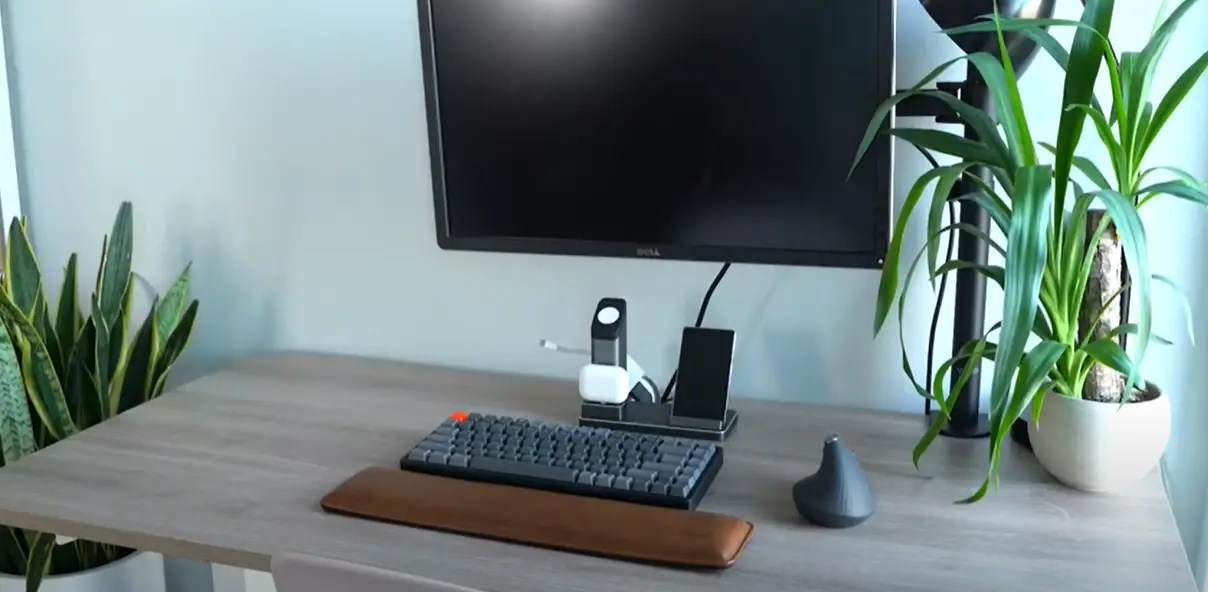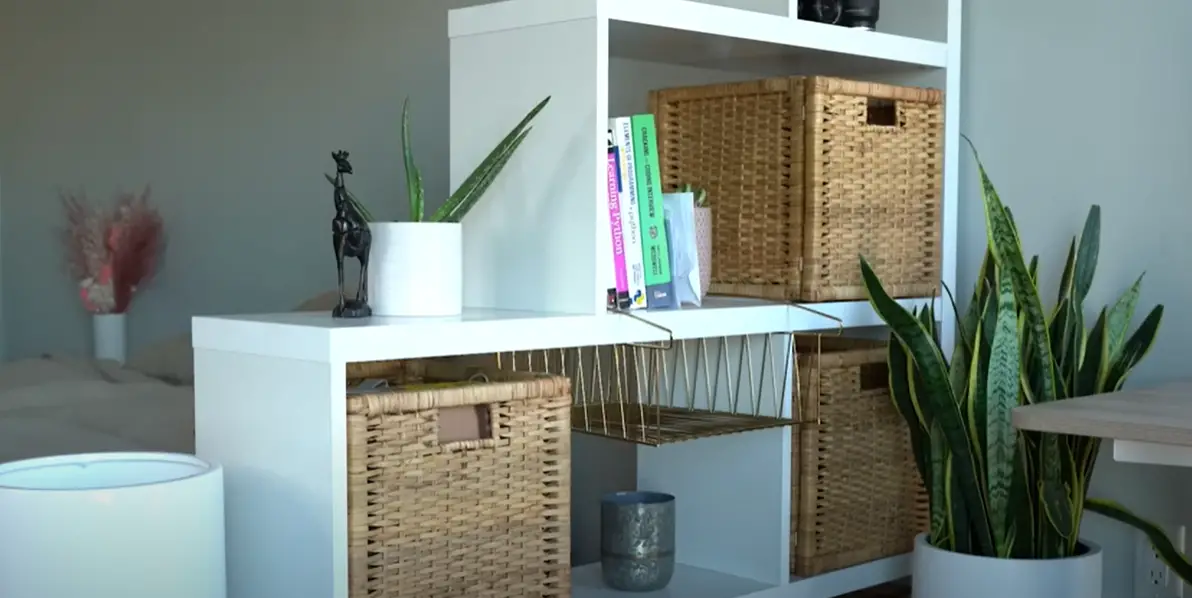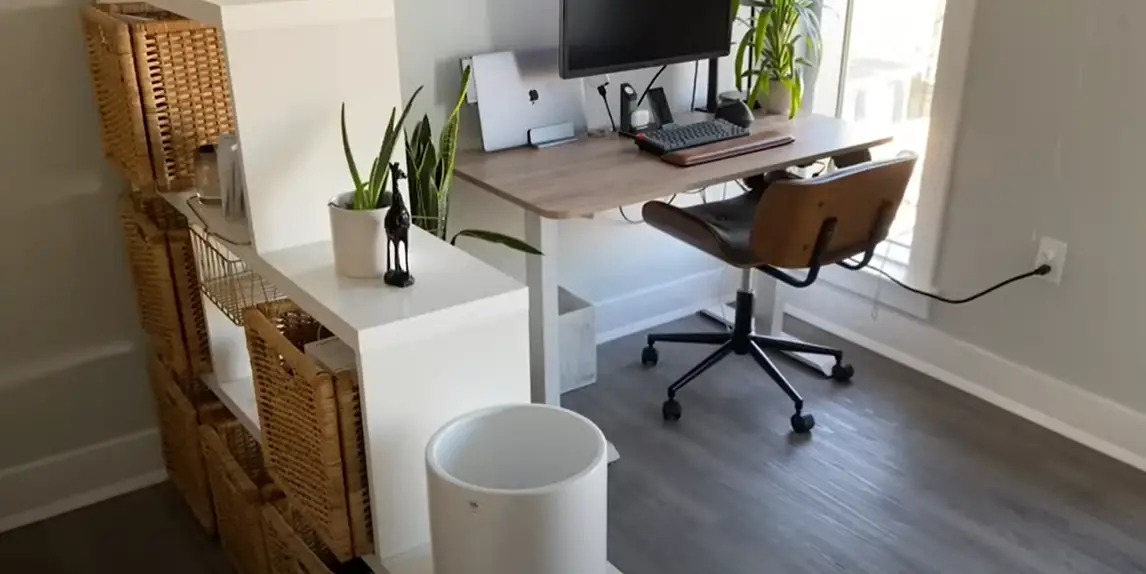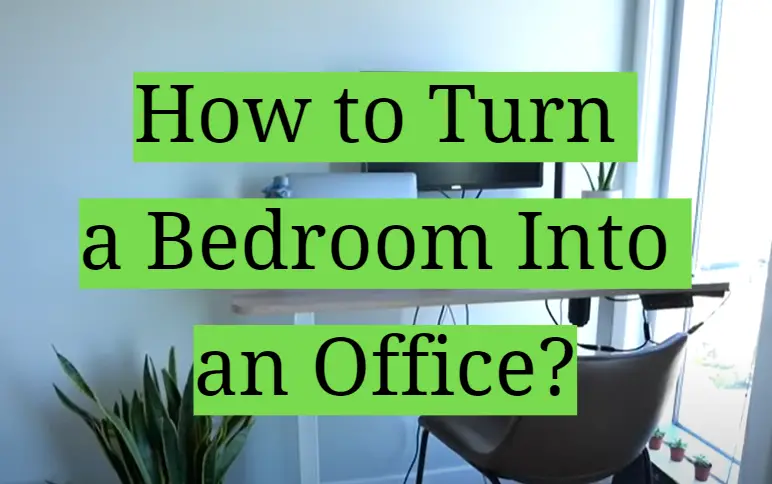Are you tired of working in a cramped, uncomfortable space? Do you dream of having an office all to yourself where you can spread out and get things done? If so, you’re not alone. A lot of people would love to have their own home office, but they don’t know how to make it happen. This blog post will discuss useful tips for turning your bedroom into the perfect home office!
Home Office Design Features
Home office design often includes features such as a comfortable workspace, sufficient storage space, and ergonomic furniture. It is important to maximize the use of natural light to create an environment that is conducive to productivity. Home offices should also include health and wellness considerations, such as proper posture when sitting at a desk or using a computer.

When designing a home office, it is essential to consider both form and function. The office should have ample shelving, drawers, and cabinets to store necessary items but should still be visually appealing with sleek lines, modern furnishings, and carefully chosen color schemes. A well-designed home office can make working from home more efficient and enjoyable.
The main features in home office design may include:
- A comfortable chair: You’ll spend a lot of time in your home office, so you must have a chair that is comfortable and supportive. Look for chairs with good lumbar support and adjustable arms and height to ensure your comfort.
- Desk lamp: Make sure your desk includes the right lighting, especially if you plan on working late into the night or early morning hours. Choose an LED task lamp that emits soft light for eye strain reduction and long-term energy efficiency.
- Organization Tools: Keep your home office organized with storage solutions such as filing cabinets and shelves or drawers for supplies like pens, paper clips, and sticky notes. Also, consider bamboo or cork boards to hang reminders, calendars, and other important documents.
- Technology: Invest in high-quality technology, such as a laptop or computer with sufficient memory, processor speed, and storage capacity for the tasks you will be performing on it.
- Ergonomic Accessories: To ensure your posture is correct when seated at a desk or using a computer, consider adding ergonomic accessories like wrist rests and footrests to your home office setup.
- Window Treatments: If your home office has windows, make sure to cover them with privacy curtains or shades to prevent glare from the sun or too much light from entering the room. This will also help reduce noise if you live in a busy neighborhood.
- Decor: Create a pleasant and inspiring workspace with artwork, plants, and other decorative items that reflect your style. This will help make your home office an inviting place to work [1].
How to Turn a Small Bedroom Into an Office in 10 Steps
1: Define the Number of Users – This Will Influence the Design
Before beginning the process of transforming a small bedroom into an office, it’s important to consider how many users will be using the space. If the room is only for one person, then there won’t need to be as much furniture or organization. However, if two or more people will be utilizing the space, then it may require additional planning and design elements to accommodate everyone comfortably.
2: Factor in Ease of Accessibility
In creating a home office within a small bedroom, accessibility should always be taken into consideration. This means making sure that items such as desks, chairs, and filing cabinets are easy to maneuver and reach without having to strain oneself. The layout of the room should also prioritize convenience so that all items necessary for work are within easy reach.
3: Decide Where to Put the Essential Features
When transforming a small bedroom into an office, it’s important to decide which features are essential and where they should be placed. A desk is typically the primary focus of any home office, and it’s best to place this at the center of the room so that everything else is arranged around it.

Storage areas such as filing cabinets or shelves should also be considered; these can be positioned against walls or in vacant corners of the room.
4: Choose an Appropriate Desk and Chair
When selecting a desk and chair, it’s important to choose pieces that are both comfortable and functional. Desks with drawers or shelves may be ideal for those who need additional storage space while standing desks can help promote a healthy posture during long hours of work. As for seating, office chairs with adjustable heights and backrests are recommended as they provide support and comfort throughout the day.
5: Utilize Wall Space
In order to maximize the space in a small bedroom turned office, it’s important to utilize wall space effectively. This means hanging items such as bulletin boards or whiteboards on the walls so that information can be easily accessed and updated. Wall-mounted shelves or cabinets can also be used to store documents and other items.
6: Choose a Storage Solution That Suits You
Depending on your needs, there are a variety of storage solutions available for home offices. From filing cabinets to boxes and baskets, it’s important to find an option that works best for you. This can help ensure that all documents and items are organized efficiently while also making them readily accessible when needed.
7: Select Additional Equipment
Depending on what is going to be used in the office, additional equipment may need to be purchased. For example, a printer or scanner may be necessary for those working with documents regularly. It’s important to consider any additional items needed and make sure that there is enough room for them within the small bedroom office.

8: Choose Lighting that Suits When You Work
Lighting can make a huge difference when it comes to creating an office in a small bedroom. Depending on when you prefer to work, it may be beneficial to install both natural and artificial lights. This will provide illumination for daytime work as well as a dimmer light source during the evening hours. As lightning for a home office, you can use table lamps, wall sconces, and pendant lights to create a cozy atmosphere.
9: Place the Desk Optimally
When deciding the location of the desk, it’s important to keep in mind how often you’ll be using it. If the desk is only occasionally used, then it can be positioned away from the main area of the room. However, if it’s going to be utilized regularly, then having a designated spot right near the entrance may be ideal.
10. Make Full Use of the Office – Add Seating if Possible
It’s important to make full use of the office space by adding seating if possible. A small armchair or sofa will allow you to have visitors over during work hours and provide a comfortable spot to take breaks. This can help create an environment that is both productive and inviting [2].
11. Choose Décor Pieces and Create a Theme
The last step in creating an office from a small bedroom is to choose décor pieces and create a theme. This can be done by hanging artwork on the walls or introducing items such as house plants.
It’s also important to ensure that any color palette used complements the overall design of the room for a cohesive look.
12: Add Some Personal Touches

When transforming a small bedroom into an office, don’t forget to add some personal touches! This could include items like artwork or photographs that will make the space feel inviting and comfortable. It’s also helpful to have plants around as they can help reduce fatigue and stress levels while boosting productivity levels.
13: Get Creative with Organization
When transforming a small bedroom into an office, it’s important to get creative with the organization. Utilizing vertical space and keeping items off of the floor are two ways to effectively create more room within the space. As mentioned previously, hanging shelves or baskets on walls can also be used to store items while still leaving plenty of floor area free.
14: Incorporate Elements of Relaxation
Incorporating elements of relaxation can help break up long hours of work and provide a space for respite. This could be done through the addition of a cozy armchair or hammock, allowing you to take micro-naps during work hours. Adding some soothing music or inviting scents can also help create an atmosphere that encourages relaxation and productivity.
15: Consider If You Need Professional Help
If all else fails, consider whether you need professional help in creating your office from a small bedroom. There are plenty of interior designers who specialize in home office design solutions, so don’t be afraid to seek out their services if needed. With their expertise, they can help transform your small bedroom into a functional and stylish workspace.
What instruments do you need to Turn a Bedroom into an Office?
To turn a bedroom into an office, you’ll need some basic instruments to help make the transition comfortable and effective. The following items are necessary:
- A desk or table with plenty of workspaces
- A comfortable chair that is adjustable in height
- Desk lamp for task lighting
- Bookshelf or cabinet to store papers, supplies, and equipment
- Computer and/or laptop with appropriate programs installed on it
- Wireless router and modem for internet access
- Printer or multifunction device such as a scanner or fax machine
- Phone line or VOIP system for calls
- Cables, power strips, and other connected devices
- Organizational tools such as filing cabinets, binders, and folders
Decorative items such as plants or artwork to help make the environment more inviting.

These instruments will help you create a comfortable, productive workspace that is tailored to your needs and preferences. Consider also investing in soundproofing materials if noise levels are an issue, or adding ergonomic equipment to keep you comfortable during long work hours.
The benefits of working from a home office
Working from a home office has numerous benefits, both in terms of convenience and cost savings.
Here are some of the major perks:
- Increased Productivity – When you work from home, you don’t have to deal with the distractions and noise associated with an open office environment. This allows you to stay focused on your work and be more productive.
- Cost Savings – The costs associated with running your own home office are much lower than renting out an office space for yourself or hiring a team of employees to do the job for you. You can save money by avoiding expensive overhead costs such as rent, utilities, and employee salaries.
- Flexibility – Working from a home office gives you the flexibility to work whenever you want, from wherever you have access to an internet connection. You don’t have to be tied down to a set schedule or daily commute.
- Comfort – Working from home offers a much more comfortable working environment than most office spaces, with your own personal space and no desk sharing needed. This allows for an improved mental state as well, since you don’t have to worry about others invading your personal bubble.
- Increased Focus – When working from a home office, you can reduce outside distractions that may cause disruption in productivity levels and eliminate any need for multitasking that would otherwise take away focus.
- Improved Health – With no commute required, working from a home office means less time spent in traffic, allowing you to make healthier choices during the work day such as eating healthier meals and taking more frequent breaks.
- More Time with Family – Working from a home office allows for more flexibility in scheduling, meaning that you can spend more quality time with your loved ones whenever you’re not at work. This ultimately leads to greater job satisfaction and improved well-being.
Overall, working from a home office can offer numerous benefits for those looking for an alternative to traditional office settings. From increased productivity and cost savings to comfort and increased focus, there are many advantages to be gained by choosing this option for your business or career needs [4].
How to turn a bedroom into an office quickly?
Making your bedroom into an office space quickly doesn’t have to be complicated! Here are a few tips to get you started:
- Start by decluttering the space – make sure it’s free of any unnecessary items that could distract you from work. If necessary, move furniture or other items out of the area to create more room for an office setup.
- Choose a comfortable chair and put it in front of your desk. Make sure it provides good lumbar support and adjust its height so you’re able to sit comfortably while working on the computer or writing.
- Select a desk that fits in the available space and suits your needs – make sure there is enough space to store all your office supplies and electronic devices.
- Add shelves or cabinets for extra storage space, and make sure they’re easy to access so you can quickly grab what you need while working.
- Create a filing system that works for you – this could be done with labels or folders, depending on the amount of paperwork you have to manage in your home office.
- If possible, set up a separate area for phone calls and video conferencing – like a corner desk with good lighting and some soundproofing if needed.
- Finally, add personal touches that make the space feel more inviting – like plants, artwork, photos, or other items that bring you joy.
Following these steps and making your bedroom into an office space should take no time at all – but remember, it’s important to make sure you have a comfortable workspace that lets you concentrate on work without any distractions!
FAQ
How do you set up an office in a small bedroom?
Setting up an office in a small bedroom can be challenging, but it is possible. The key is to make the most of your available space and create an efficient working area that fits your needs. Start by determining what type of equipment you need for your office and lay out the furniture accordingly.
The organization is important when setting up an office in a small space.
Utilize all areas of your desk – use drawer organizers, baskets, and other storage devices to keep things neat. Invest in a comfortable chair that offers ergonomic support.
Finally, add some personal touches to make it feel more like home. Hang pictures or artwork and incorporate a few green plants to bring the room alive. With these tips, you can create the perfect office space in an otherwise small bedroom.
How can I turn my bedroom into a study room?
If you are looking to turn your bedroom into a study room, it is important to first assess what type of work you will be doing. Once you have a clear idea of how the space will be used, begin by picking a comfortable chair and desk that fit the size of the room and provide enough storage for your materials. Incorporate good lighting such as desk lamps or natural light from windows.
Place bookshelves near the desk so all information is easily accessible. Hang inspirational artwork on the walls and use bright colors to stimulate creativity.
Finally, add some plants or some other decorative touches to make the room feel more inviting and cozy.
Can your home office be in your bedroom?
Yes, it is possible to have a home office in your bedroom. Designate an area for work and set up your desk, chair, and any other items you need for the job in that space. Try to keep the workspace free of distractions by removing clutter or any unnecessary items.
Make sure to utilize good lightings, such as natural light from windows or overhead lights, so you can see what you are working on. Additionally, stay organized and make sure all supplies have their place so they don’t take up too much room in your bedroom.
Where is the best place to put a desk in a bedroom?
The best place to put a desk in a bedroom is near a window. Natural light from the window will help your productivity and reduce eyestrain while you work. If possible, position the desk directly across from the window so that light comes in evenly on both sides of you. Make sure there is enough room to move around the desk and chair, as well as plenty of outlets for your equipment.
Additionally, be sure to choose a comfortable chair that offers ergonomic support if you plan on spending long hours at the desk.
Should my desk face the wall or the room?
Whether your desk should face the wall or the room depends on how you plan to use it. If you will be spending long hours at the desk, facing out into the room can help reduce eyestrain and allow more natural light to come in. On the other hand, if your desk is mainly used for writing or paperwork, then placing it facing a wall may offer more privacy and a better-organized workspace.
Ultimately, it comes down to what works best for you and your needs.
Do you pay bedroom tax if you work?
No, the bedroom tax is a form of housing benefit that is impacted by the number of bedrooms in your home. It does not apply to people who work; instead, it applies to people receiving housing benefits from the government. Therefore, if you are working and pay your rent or mortgage yourself, you will not be affected by the bedroom tax.
However, if you do receive government-funded housing benefits and have more bedrooms than necessary for the size of your household then you may be subject to the bedroom tax.
The rules vary across local authorities so it’s best to check your local council’s website or speak with them directly to see how they apply in your area.
What not to keep in your home office?
It is important to be mindful of what items you keep in your home office, as having too many unnecessary items can quickly turn the room into a cluttered mess. Avoid bringing in items that are not related to work such as toys, decorations, or anything else that might cause distractions while working. Additionally, if possible try to limit your technology use in the space by not keeping any gaming consoles or television sets in the office.
Finally, make sure to store away any personal documents and sensitive information outside of the workspace for added security.
Should you have a phone in your home office?
Having a phone in your home office can be beneficial, as it enables you to easily stay connected with colleagues and clients.
Additionally, having a dedicated office line helps ensure that personal calls do not distract from work-related tasks. However, if the use of a phone is not essential for your job then it may be best to keep this item out of the workspace in order to reduce distractions.
Ultimately, it comes down to what works best for you and your needs so make sure to consider all options before making any decisions.
Useful Video: Building A Home Office In My Bedroom (Extreme Makeover)| Work From Home
Conclusion
Turning a bedroom into an office requires careful planning and a lot of effort. From selecting the right furniture to choosing to light and taking into account ergonomics, there’s a lot to consider. Despite all the work that goes into it, creating an effective office space in your bedroom can be incredibly rewarding. It provides you with the opportunity to have a functional workspace without having to leave the house or rent an extra room. Developing such a setup is sure to benefit any freelancer or remote worker and ensure that they stay productive while maximizing their limited space and budget. With good planning and organization, anyone can easily turn their bedroom into an efficient working environment.
References
- https://www.roomsketcher.com/blog/home-office-design/
- https://bedroomstylereviews.com/how-to-turn-a-small-bedroom-into-an-office/
- https://www.thebalancemoney.com/a-checklist-for-setting-up-your-home-office-2951767
- https://www.flexjobs.com/blog/post/benefits-of-remote-work/










Leave a Reply